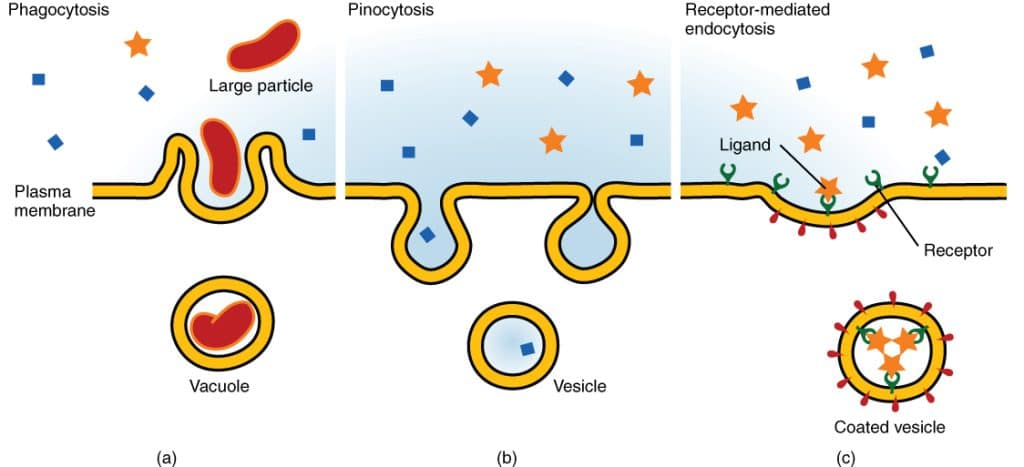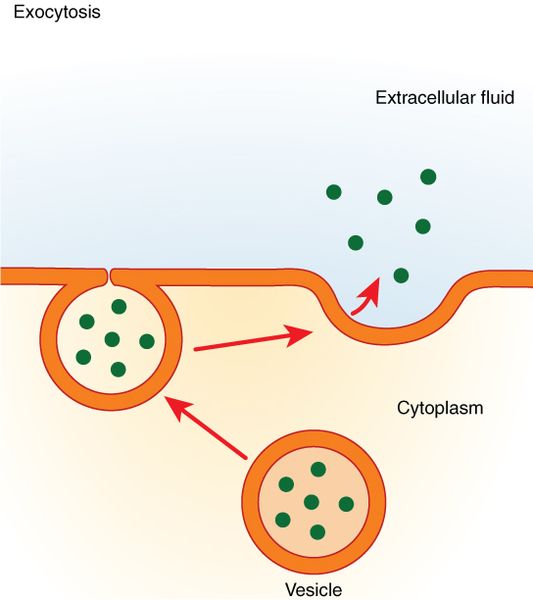Endocytosis and exocytosis are the names given to the active, bulk transport of products across the cell membrane. These processes allow larger molecules that cannot diffuse through the lipid bilayer to cross the membrane.
Endocytosis is the process by which substances are engulfed into the cell. Exocytosis is the reverse; the process by which substances are released from the cell.
In this article, we will discuss the processes of endocytosis and exocytosis, and we will consider clinical conditions which result from defects in these processes.
Endocytosis
Endocytosis, the process by which large molecules are internalised into the cell, occurs when foreign material is engulfed within the cell membrane, which then forms a vesicle containing the ingested material. There are three main subtypes of endocytosis, as seen in Figure 1.

Fig 1 – Diagram showing the three forms of endocytosis
- Phagocytosis – This is the process of engulfing large, solid particles such as bacteria into the cell for immune purposes. Extensions of the cytoplasm, termed pseudopodia (‘false feet’), sense, surround and enclose the target, creating a vacuole or phagosome on the inside of the cell membrane. This allows the process of phagocytosis to be highly specific.
- Pincytosis – This describes the non-specific uptake of fluid surrounding the cell, allowing it to take in nutrients such as ions, enzymes and hormones. In this process, the cell membrane invaginates, before budding off to create a vesicle known as a pinosome.
- Receptor-mediated endocytosis – uptake of specific target substances, such as iron, via their receptor. Receptors cluster in regions termed coated pits, as they are coated with proteins such as clathrin. Clathrin causes the coated pit to invaginate and become a vesicle, bringing the desired ligand into the cell. This process can be hijacked to allow for toxins to enter the cell, such as cholera.
Exocytosis
Exocytosis is a form of active transport through which large molecules are moved from the interior to the exterior of the cell. Vesicles are packaged within the cell and transported to the cell membrane, where their phospholipid bilayers fuse. This allows the contents to be released outside the cell.
In some cases, the vesicle will only fuse temporarily before reforming on the interior of the cell. Alternatively, the vesicle may fuse completely, becoming a permanent part of the cell membrane.
Exocytosis is used in many areas of the body, including neurotransmitter release at synapses or release of secretions in the sweat glands. Glands which secrete their products via exocytosis are termed merocrine.

Fig 2 – Diagram showing exocytosis
Clinical Relevance – Familial hypercholesterolaemia
Low-Density Lipoproteins (LDLs) are taken into the cell via receptor-mediated endocytosis, following binding with the LDL receptor. Genetic mutations in the gene which codes for the LDL receptor can prevent successful binding to the receptor. This prevents LDLs from being taken into the cell, causing high cholesterol concentration in the blood.
If left untreated, men with familial hypercholesterolaemia are at a 50% risk for a fatal or nonfatal coronary event by age 50 years and women are at a 30% risk by age 60.
